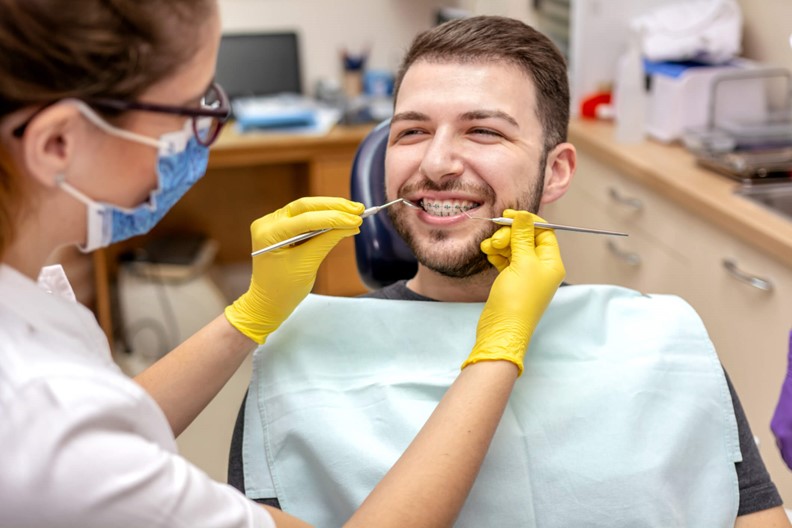Signs You May Need Orthodontic Treatment as an Adult
Orthodontic treatment isn’t just for kids and teens. More adults are choosing to straighten their teeth these days, thanks to advances in technology that make treatment more discreet and comfortable than ever. If you’ve noticed changes in your bite, discomfort when chewing, or a general lack of confidence in your smile, you might be a candidate for adult orthodontics. Explore your options to help you find a teeth-straightening method that fits your modern lifestyle and delivers long-lasting results.

Why Adults Might Pursue Orthodontic Treatment
Many adults seek out orthodontics for cosmetic reasons, but the benefits extend far beyond appearance. Here’s how straightening your teeth can improve oral health:
- Ease of cleaning: Straight teeth are easier to brush and floss, which lowers the risk of cavities and gum disease.
- Stronger bite: Misaligned bites wear out teeth unevenly and may cause jaw strain. Correcting the alignment protects your teeth and reduces discomfort.
- Boosted confidence: A symmetrical smile helps you feel more self-assured during personal and professional interactions. Plus, with advancements in clear aligners, you can straighten your teeth without feeling self-conscious during treatment.
Signs You Could Benefit From Clear Aligners for Adults
You don’t need to wait until things get really uncomfortable to think about orthodontics. Here are some common signs that it might be time for treatment:
- Crowding and overlapping teeth: When teeth compete for space, they can twist or overlap, impacting your smile and making your hygiene routine more difficult.
- Excess spacing: Large gaps between teeth make chewing less effective and disrupt the balance of your bite.
- Bite misalignment: An overbite, underbite, or crossbite may cause jaw pain, uneven tooth wear, or difficulty speaking.
- Recurring jaw issues: Clicking, popping, or tension in the jaw may point to misalignment that an orthodontist can help you address.
- Lack of confidence: The urge to cover your mouth when you smile, laugh, or speak could mean you need help with your crooked teeth.
- Shifting teeth from previous orthodontic care: Even if you had braces as a teenager, teeth can move later in life, especially if you neglected to wear your retainer. Adult orthodontics offers a second chance to align your smile.
Modern Options for Straightening Teeth
Adults often hesitate because they picture needing traditional metal braces. Luckily, today’s treatment options are diverse. Your choices include:
- Invisalign: These clear, plastic aligners—often dubbed “invisible braces”—discreetly shift your teeth into place. They’re also removable, which makes eating and brushing easier.
- Ceramic braces: Less visible than metal, these braces use tooth-colored brackets for a more subtle appearance.
- Lingual braces: These braces are placed on the back of your teeth, staying out of sight while still delivering strong results.
- Traditional braces: While they’re the most visible, metal braces are still among the most effective ways to correct complex alignment issues.
What to Expect From the Treatment Process
Starting adult orthodontic treatment begins with a consultation. The dentist evaluates your bite, takes X-rays or scans, and builds a personalized plan. Once a decision is made about braces vs. clear aligners, treatment can begin.
For ceramic, lingual, or traditional braces, brackets and wires are applied directly to your teeth. You’ll come in every few weeks for adjustments that keep your treatment on track. If you choose Invisalign, you’ll wear a series of clear, custom aligners that gradually shift your smile. Regular office visits are still necessary to monitor your progress.
Treatment times vary. Many patients complete treatment in under 12 months, while others may require a few years to fully correct complex bite issues. Consistency is the most important factor in achieving results.
Maintaining Oral Health During Orthodontic Treatment
Oral hygiene is always important, but even more so while wearing braces. Food particles can easily become trapped, creating an environment for bacteria. With these steps, you can protect your smile while your teeth move into place:
- Brush carefully after every meal to keep your teeth and braces clean.
- Floss daily. You may benefit from floss threaders or a water flosser if you have ceramic, lingual, or traditional braces.
- Rinse with antibacterial mouthwash to keep your gums healthy.
- Visit your dentist for routine cleanings and oral exams.
- Avoid sticky, hard, or sugary foods that can damage oral appliances or increase cavity risk.
Life After Orthodontic Treatment
When treatment ends, you’ll be given a retainer to hold your teeth in their new positions and prevent them from drifting back. Wearing one as prescribed helps your results last. You’ll also want to maintain strong hygiene practices and regular dental visits to keep your smile healthy and bright.
Ready to Transform Your Smile?
S&L Dental has decades of experience transforming smiles in the Scottsdale area. We focus on patient comfort and life-changing experiences for adults who are ready for straighter teeth and a more confident smile. If you’ve been considering adult braces, schedule a consultation at our office in Paradise Valley today to get started.

